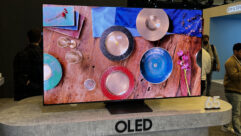Fascinating Facts About Oleds
Eastman-Kodak is credited with inventing organic light-emitting diodes (OLEDs) in the early 1980s.
- Eastman-Kodak is credited with inventing organic light-emitting diodes (OLEDs) in the early 1980s.
- Like a light-emitting diode (LED), an OLED is a solid state semiconductor, between 100 and 500 nanometers thick — about 200 times thinner than a human hair.
- What’s it made of? A clear plastic, glass, or foil substrate supports the OLED. When current is flowing, a transparent anode removes electrons. Organic layers of organic molecules or polymers comprise a conducting layer to transport the “holes” from the anode. An emissive layer transports electrons from the cathode, which injects electrons when current is flowing.
- Kodak used organic molecules, which had to be applied to the substrate in a vacuum — an expensive process. Different organic molecules create different colors of light.
- Kodak signed a deal with Sanyo Electric Co. and Ulvac Japan to produce the first prototypes in early 2001, with mass production to start in 2002.
- A 2000 report from research firm Stanford Resources of San Jose, Calif., predicted the OLED market would grow from $3 million in 1999 to $717 million in 2005.
- OLEDs emit light through electrophosphorescence. In the 1990s, OLED makers turned to cheaper inkjet printing, spraying polymers onto substrates to create an organic light-emitting polymer (OLEP).
- The organic electroluminescence of an OLEP is an electro-chemical reaction similar to the bioluminescence that makes a firefly and certain fungi, bacteria, and deep sea fish glow.
- OLEDs generate very little heat — so little that makers of the Optimus Maximus PC keyboard put an OLED in every key that can be programmed to display any image you like. Available this holiday season for $1,688.97.
- Used in displays, OLEDs have other advantages over LEDs and liquid crystal displays (LCDs). OLED plastic, organic layers are thinner, lighter, and more flexible. Think roll-up plastic “keyboards” or e-paper.
- Because OLEDs generate light, they don’t require back-lighting as LCDs do. This not only cuts down on power consumption — less than 10 volts — but because the electrode sandwich is thinner, there is less diffusion of the light and less light is lost, making OLED displays sharper and brighter than LCDs.
- The red and green OLED films are good for as many as 40,000 hours. The blue fades after 1,000 hours.
- Unfortunately, like the Wicked Witch of the West, OLEDs are easily destroyed by water.
- The Kodak/Sanyo venture produced some OLED screens in 2003, but in 2006, they abandoned the venture.
- Sony has scheduled a 2007 release — in Japan — of an 11-inch OLED TV. It’s 3.0 mm thick, has a contrast ratio of 1,000,000:1 and is capable of full HD 1080p resolution.
- Toshiba plans to ship a 30-inch organic electroluminescence display in 2009.
- In July, Dutch information and media company VNU reported that display market analysts are predicting shipments of OLED TVs “to reach 3 million by 2011.”
Sources: Sanyo, Eastman-Kodak, Sony, howstuffworks.com.









